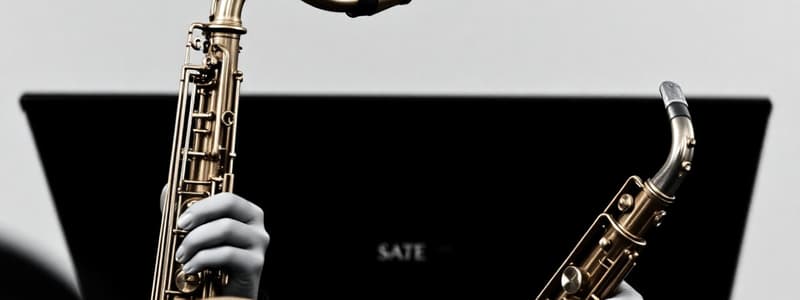Podcast
Questions and Answers
Which component is responsible for supporting the saxophone's body?
Which component is responsible for supporting the saxophone's body?
- Pad cups
- Main body
- Bell brace
- Thumb rest (correct)
Why is it generally recommended to wet the reed before playing a saxophone?
Why is it generally recommended to wet the reed before playing a saxophone?
- To improve the reed's grip on the mouthpiece.
- To sanitize the reed prior to use.
- To prevent damage to the mouthpiece.
- To facilitate proper vibration of the reed. (correct)
The term 'embouchure' in saxophone playing specifically refers to what aspect of playing?
The term 'embouchure' in saxophone playing specifically refers to what aspect of playing?
- The way a player uses their facial muscles and lip shape when blowing. (correct)
- The process of selecting the correct reed strength.
- The method of cleaning and maintaining the instrument.
- The technique of fingering different notes.
How can a saxophone player achieve a note one octave higher than the one being played?
How can a saxophone player achieve a note one octave higher than the one being played?
Which saxophone type is known for NOT having an S-shaped body?
Which saxophone type is known for NOT having an S-shaped body?
Which of the following is a primary reason why the saxophone wasn't widely adopted as a standard orchestral instrument despite its invention for that purpose?
Which of the following is a primary reason why the saxophone wasn't widely adopted as a standard orchestral instrument despite its invention for that purpose?
Adolphe Sax's original saxophone design incorporated elements from various instruments. Which combination of instrument features best describes his invention?
Adolphe Sax's original saxophone design incorporated elements from various instruments. Which combination of instrument features best describes his invention?
How did the expiration of Adolphe Sax's patent in 1866 most directly impact the development and variety of saxophones?
How did the expiration of Adolphe Sax's patent in 1866 most directly impact the development and variety of saxophones?
Considering Adolphe Sax's intention to create saxophones for both orchestral and band use, which of the following pairs correctly matches the intended purpose with the instrument's pitch?
Considering Adolphe Sax's intention to create saxophones for both orchestral and band use, which of the following pairs correctly matches the intended purpose with the instrument's pitch?
What does the quote from Charlie Parker, 'Don't play the saxophone. Let it play you,' suggest about his approach to playing the instrument?
What does the quote from Charlie Parker, 'Don't play the saxophone. Let it play you,' suggest about his approach to playing the instrument?
If a musician is proficient in playing the alto saxophone, what does the content imply about their ability to play other types of saxophones?
If a musician is proficient in playing the alto saxophone, what does the content imply about their ability to play other types of saxophones?
Which of the following lists arranges saxophone types from highest to lowest pitch?
Which of the following lists arranges saxophone types from highest to lowest pitch?
How did the association of the saxophone with swing and big band music in the 1940s contribute to its evolving role in music history?
How did the association of the saxophone with swing and big band music in the 1940s contribute to its evolving role in music history?
Flashcards
Bell Brace
Bell Brace
Supports the saxophone's bell.
Bell (Saxophone)
Bell (Saxophone)
The flared end of the saxophone that projects the sound.
Main Body (Saxophone)
Main Body (Saxophone)
The main section of the saxophone, usually S-shaped (except for soprano saxophones).
Saxophone Reed
Saxophone Reed
Signup and view all the flashcards
Embouchure
Embouchure
Signup and view all the flashcards
Saxophone
Saxophone
Signup and view all the flashcards
Adolphe Sax
Adolphe Sax
Signup and view all the flashcards
Saxophone's Musical Path
Saxophone's Musical Path
Signup and view all the flashcards
Saxophone Parts
Saxophone Parts
Signup and view all the flashcards
John Coltrane
John Coltrane
Signup and view all the flashcards
Stan Getz
Stan Getz
Signup and view all the flashcards
Saxophone Sizes
Saxophone Sizes
Signup and view all the flashcards
Saxophone Types
Saxophone Types
Signup and view all the flashcards
Study Notes
- The saxophone was invented over 150 years ago in Paris for use in military bands and orchestras.
- Though the saxophone is made of brass, it is a woodwind instrument.
- The saxophone was not initially embraced by composers for orchestral pieces, but it was adopted by jazz and swing bands, becoming a popular solo instrument and is now used in many styles of music.
Saxophone origins
- In the early 1840s, Adolphe Sax, a Belgian instrument maker, invented the saxophone in Paris.
- Sax combined a clarinet-style reed and mouthpiece design, with a key system from the oboe and flute and the conical brass body of the "ophicleide" – a brass instrument at that time.
- The design allowed the saxophone to project sound like a horn, but with the versatility of a woodwind instrument.
- In 1844, composer Hector Berlioz featured Sax's bass saxophone in one of his choral concerts.
- Sax received the patent for making saxophones in 1846, covering 14 versions of the original design.
- By 1850, the saxophone became popular in French military bands.
- Other instrument makers adapted Sax's original design, adding extra keys, once Sax's patent expired in 1866.
- The bass saxophone became very common in many jazz music recordings from the 1920s.
- From the 1940s onward, the saxophone became associated with swing and big band music.
- The saxophone range extends two and a half octaves.
Top saxophonists
- Jazz music has produced many impressive saxophone players.
- John Coltrane was a tenor saxophonist, composer, and band leader with a huge influence on jazz music in the 1960s and 1970s
- Stan Getz was known as "The Sound" because of his warm, perfectly controlled saxophone sound
- Sidney Bechet was a child prodigy in New Orleans.
- Charlie Parker and Courtney Pine (UK) have also greatly influenced jazz
Elements of the Saxophone
- Mouthpiece
- Reed
- Ligature
- Neck (also known as crook)
- Left-hand keys and buttons
- Bell brace
- Bell
- Main body (Only the small soprano saxophone does not have the characteristic S-shaped body.)
- The thumb rest
- Right-hand keys and buttons
- 20-23 tone holes, including two small speaker boles.
- Pad cups
- Bow
Playing the Saxophone
- Players support the reed against their bottom lip and blow across it into the mouthpiece, while fingering the keys that cover the 20 to 23 tone holes along the saxophone's length.
- Usually made of natural cane, a reed is placed in the mouthpiece. When a player blows into the mouthpiece, the reed vibrates. Wetting the reed before playing helps it vibrate correctly. Plastic reeds are available, but some players think they are not so good.
- The way players use their facial muscles and lip shape when blowing into a woodwind instrument is called "embouchure."
- Once they have mastered the technique, it can be adapted to achieve a number of different sound effects from trilling, slurring, and growling through to flutter tongue and notebend.
- Players can also achieve a note one octave above the one they are playing by adapting the shape of their throat.
Saxophone Types
- Adolphe Sax designed 14 different saxophones, which were divided into seven different types: sopranino, soprano, alto, tenor, baritone, bass, and contrabass.
- Those pitched in F and C were meant for orchestral use and those in E flat and B flat were for bands.
- They all have the same keys in the same place, so once you can play one, you should be able to play them all!
Studying That Suits You
Use AI to generate personalized quizzes and flashcards to suit your learning preferences.




